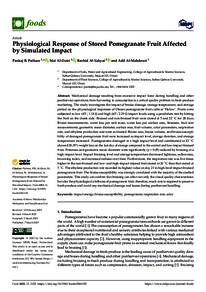Document
Physiological response of stored pomegranate fruit affected by simulated impact.
Contributors
Publisher
Foods.
Gregorian
2023-03
Language
English
English abstract
Abstract: Mechanical damage resulting from excessive impact force during handling and other
postharvest operations from harvesting to consumption is a critical quality problem in fresh produce
marketing. The study investigates the impact of bruise damage, storage temperature, and storage
period on the physiological responses of Omani pomegranate fruit cultivar 'Helow'. Fruits were
subjected to low (45◦
; 1.18 J) and high (65◦
; 2.29 J) impact levels using a pendulum test by hitting
the fruit on the cheek side. Bruised and non-bruised fruit were stored at 5 and 22 ◦C for 28 days.
Bruise measurements, water loss per unit mass, water loss per surface area, firmness, fruit size
measurements, geometric mean diameter, surface area, fruit volume, color parameters, respiration
rate, and ethylene production rate were evaluated. Bruise area, bruise volume, and bruise suscepti bility of damaged pomegranate fruit were increased as impact level, storage duration, and storage
temperature increased. Pomegranates damaged at a high impact level and conditioned at 22 ◦C
showed 20.39% weight loss on the last day of storage compared to the control and low-impact-bruised
fruit. Firmness and geometric mean diameter were significantly (p < 0.05) reduced by bruising at a
high impact level. Impact bruising level and storage temperature decreased lightness, yellowness,
browning index, and increased redness over time. Furthermore, the respiration rate was five times
higher in the non-bruised and low- and high-impact-injured fruit stored at 22 ◦C than that stored at
5
◦C. The ethylene production rate recorded its highest value on day 21 in high-level-impact-bruised
pomegranate fruit. The bruise susceptibility was strongly correlated with the majority of the studied
parameters. This study can confirm that bruising can affect not only the visual quality characteristics
but also the physiological attributes of pomegranate fruit; therefore, much care is required to preserve
fresh produce and avoid any mechanical damage and losses during postharvest handling.
Member of
Category
Journal articles

